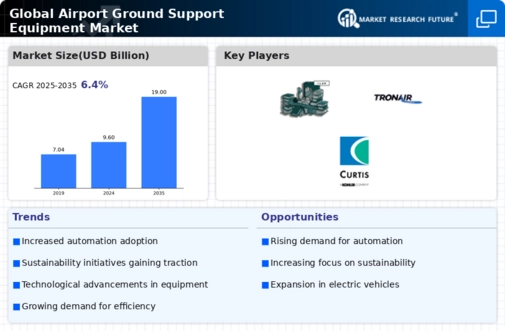Airport Ground Support Equipment Size
Airport Ground Support Equipment Market Growth Projections and Opportunities
The airport ground support equipment (GSE) market is influenced by several dynamic factors that reflect the evolving landscape of the aviation industry and the demand for efficient ground handling operations. One key market dynamic is the continuous growth in air passenger traffic worldwide. As the global aviation sector expands, airports experience increased aircraft movements, creating a demand for advanced and reliable ground support equipment. The need to handle larger volumes of passengers and cargo efficiently drives the market dynamics, prompting airports to invest in modern GSE that enhances turnaround times and operational efficiency.
Stringent safety and environmental regulations contribute significantly to the market dynamics of airport ground support equipment. Compliance with international safety standards and environmental regulations is a paramount concern for airports and ground handling service providers. The market dynamics are shaped by the continuous development of GSE technologies that align with safety standards, emission requirements, and noise reduction measures. The demand for eco-friendly and energy-efficient GSE solutions is on the rise, reflecting the industry's commitment to sustainable and responsible aviation practices.
Technological advancements play a pivotal role in shaping the dynamics of the airport GSE market. The introduction of smart and connected technologies, such as telematics, sensors, and automation, enhances the efficiency and performance of ground support equipment. The market dynamics are influenced by the integration of digital solutions that enable real-time monitoring, predictive maintenance, and data-driven decision-making. As airports seek to modernize their operations, the adoption of cutting-edge technologies in GSE becomes a key market dynamic.
The increasing trend toward privatization and outsourcing of ground handling services influences the market dynamics of airport ground support equipment. Airports are increasingly opting to outsource ground handling operations to specialized service providers, creating a demand for advanced and versatile GSE. The market dynamics are shaped by the need for ground support equipment that can cater to diverse aircraft types and handle various ground handling functions efficiently. Outsourcing trends contribute to a more competitive landscape, prompting GSE manufacturers to offer customized and cost-effective solutions.
The rise of low-cost carriers and the expansion of regional airports contribute to the market dynamics of airport ground support equipment. Smaller and regional airports, experiencing increased traffic due to the growth of low-cost carriers, require cost-effective and scalable ground support solutions. The market dynamics are influenced by the need for compact and versatile GSE that can accommodate the specific requirements of regional airports, reflecting the adaptability of manufacturers to diverse market segments.
Economic factors, including fluctuations in fuel prices and overall economic conditions, impact the market dynamics of airport ground support equipment. The aviation industry is sensitive to economic trends, and variations in fuel prices directly influence operational costs for airlines and airports. The market dynamics are shaped by the need for fuel-efficient GSE solutions that contribute to cost savings. Economic conditions also influence capital expenditure decisions, with airports seeking cost-effective and durable GSE solutions that align with budgetary constraints.
The global focus on airport infrastructure development and expansion projects is a significant market dynamic influencing the demand for ground support equipment. As airports undergo expansions, renovations, and capacity enhancements, the market dynamics are driven by the requirement for advanced GSE that can support increased aircraft movements and passenger loads. The demand for GSE that integrates seamlessly with modern airport infrastructure becomes a crucial factor in the market dynamics, reflecting the industry's commitment to enhancing overall airport efficiency.
Market consolidation and strategic partnerships among GSE manufacturers contribute to the dynamics of the airport ground support equipment market. Collaborations, mergers, and acquisitions shape the competitive landscape, influencing market dynamics by creating stronger market players with a diverse portfolio of GSE solutions. The ability of manufacturers to establish strategic alliances and partnerships enhances their market presence, allowing them to offer comprehensive and integrated GSE solutions to airports and ground handling service providers.







Leave a Comment